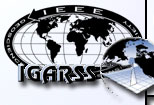|
|
| 2004
IEEE International Geoscience and Remote Sensing Symposium
Danielle Graves,
October 26, 2004,
ONR-NRTS
September 19-26,2004,
Anchorage, Alaska
|
On Sunday, September 19, 2004, I,
along with several other Minority Student Travel Program (MSTP)
participants traveled to Anchorage, Alaska to attend the 2004
IEEE International Geoscience and Remote Sensing Symposium
(IGARSS). MSTP participants were from several institutions
from all over the world including Virginia State University,
Norfolk State University, Hampton University, Clark Atlanta
University, the University of Arizona, Morgan State, the University
of Johannesburg, South Africa, and Southern University. Our
travel and participation in this symposium was supported and
made possible by the efforts of Mr. Charles Luther of the Office
of Naval Research, Dr. Linda Hayden, Principal Investigator-ECSU
ONR/NRTS Program, and Dr. Mohamed Mohamed of Lockheed Martin.
This year's theme was "Science for Society: Exploring
and Managing a Changing Planet" On Sunday I attended the
Opening Reception which was held in the Anchorage Museum of
History and Art. The reception was a "meet and greet" event
where we were able to mingle with other conference participants
and affiliates. I also had the opportunity to tour the museum
and learn about Alaska's history.
On Monday morning, I attended the plenary session entitled "Exploring
and Managing a Changing Planet" Here, conference attendees
were welcomed by Lt - Governor Loren Leman and Dr. Albin Gasiewski,
President of the IEEE Geoscience and Remote Sensing Society.
Of one-thousand plus conference attendees, fifty-one percent
were international and forty-nine percent were from North America.
Lt. Governor Leman gave us a brief history of Alaska and told
us about some of its natural wonders including Mount McKinley
(which is North America's highest peak) and glaciers. He also
informed us that Alaska is "world renowned for its ample
water, fish and game resources." Following Dr. Gasiewski,
Gov. Leman made a presentation on "Remote Sensing in Service
for Alaska." He said that "Remote sensing has been
used in Alaska for about the last thirty-five years." Some
of the uses that Alaska gets out of remote sensing include "detecting
smoke from fires as far away as Greenland, ice edge monitoring
where near real time imagery is used to advise "skippers" on
boats." Remote sensing is also used to "manage
fisheries by tracking king salmon as well as determining
stock composition
and type."
Following the plenary session, began an entire week's worth
of oral and poster presentations on topics relative to remote
sensing including: Disasters and Hazards, Cryosphere Sensing,
Land Cover Classification, Soil Moisture, Hyperspectral Sensing
Missions, Environmental Degradation and Pollution, Water Management,
Policy Society and Education, and Clouds and Aerosols.
In order to fulfill requirements of being
an MSTP participant, I made a poster presentation on a
research project from the
summer of 2003 entitled "Science, Settlement, and Remote
Sensing: Locating the Remains of the Lost Colony of Northeastern
North Carolina." This was a grand opportunity in that
I, as a minority and a student, was able to present my efforts
to the remote sensing realm to individuals from all over
the world. The directors of the MSTP program are to be commended
for their efforts in exposing minority students to an environment
where, they may have been unaware of or easily overlooked. |
|
Post
Symposium Feedback
Moogega Cooper
Validation of SABER Temperature Measurements Using Ground-based
Instruments
Department of Physics, Hampton University, Hampton, VA 23668
|
| The
benefits of the Minority Travel Program or MTP are numerous!
The IGARSS 2004 Symposium was
my first trip away from home and my first symposium experience.
With hotel and eating expenses covered, the MTP gave me the
freedom to focus my attention on becoming educated through
the symposium lectures and activities. Through the experiences
I have gained in the symposium, I have strengthened my presentation
skills and my networking skills.
During my poster session, I was approached by scientists
from various fields in remote sensing. With each question
I was asked, my knowledge in the project strengthened,
and at times, I would learn something new. For example,
I was
asked what the spatial resolution of my instrument was
and I would reply that I was unaware of this parameter.
Fortunately,
there was a young scientist who most energetically explained
what he thought it was and why. Now enlightened, I forged
forward with the knowledge of my instrument’s spatial
resolution! The feedback from the scientists is one of
the many benefits that the symposium has given to me.
One of the many exciting facets of the IGARRS symposium
is the opportunity to make connections. As a student trying
to find the best graduate school for my major, meeting contacts
from the first graduate school on my list was amazing. Furthermore,
I was ecstatic to meet international scientists from countries
to include Turkey, Germany, South Africa, and Korea. Amazingly,
one contact from Germany was so impressed with my work and
my institution that he was compelled to give a guest lecture
at Hampton University. We are currently in the process of
setting that up.
Lastly, and most importantly, the MTP allowed me the opportunity
to fellowship with other bright and successful minority students
and professors. I was given encouragement from participants
such as Dr. Mohamed and future doctor Derrick Lampkin with
respect to graduate school, which I am greatly appreciative
of. I would like to express my gratitude to all facilitators
of the program such as Dr. Charles Luther, Dr. Linda Hayden,
Mrs. Keisha Wilkins, Dr. Mohamed, and Mrs. Tammy Stein. I
would also like to thank Dr. Ali Omar for recommending me
for the MPT. The special bonds created between all MPT participants
is invaluable and will continue to hold as time goes by.
|
| |
|
|


